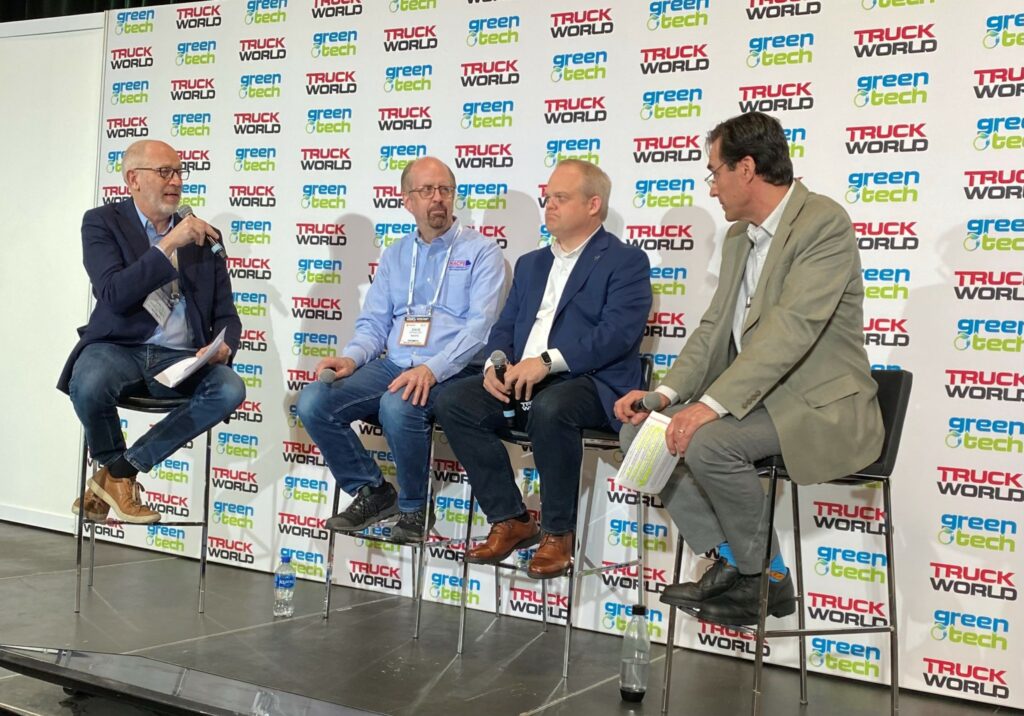Consider compromises, low-tech options when optimizing fuel economy
Fleets today have more tools than ever at their fingertips to optimize the performance of their vehicles. When Johan Agebrand, director of product marketing for Volvo Trucks North America entered the industry 25 years ago, there were 2,800 programmable parameters on a heavy-duty engine. Today, there are 35,000 to 45,000.
Adjusting those parameters, however, requires fleets to strike a balance between maximizing efficiency without compromising performance or driver satisfaction, Agebrand said, speaking on a Greentech panel on fuel efficiency at Truck World.

Adam Wolk, director of maintenance for Challenger Motor Freight said the same is true for owner-operators purchasing tractors in the secondary market.
“Often times, the evaluation of a used truck is, is there tread on the tires? And how recent is the annual [inspection]?” Wolk said. He suggested used truck buyers spend more time evaluating the specifications and ensuring the truck was built to do the job it will be tasked with. “You might want to make that concession and be that guy who’s willing to be in the right-hand lane going uphill with the hazard lights on,” he advised.
Data collection
When it comes to new technologies, Wolk said Challenger will consider any fuel-saving technology that delivers on its promises. He looks to unbiased third-party evaluations for validation, then conducts meticulous internal tests.
“We gather data like nobody’s business,” said Wolk.
And for good reason. “We have 750 power units. Add owner-operators and that makes it nor of 1,000. We spend tens of millions of dollars on fuel every year. Give me one point, that’s $100,000. If something is worth half a point and can be demonstrated by verifiable data, it’s a big chunk of change. Put that across the fleet and that’s a lot of fuel, so I’m interested in almost anything as long as it can be demonstrated,” he said.
Some of those technologies are decidedly low-tech. Perforated mudflaps on every position of the truck and trailer, for instance, can slash fuel consumption by 1%. And Agebrand said slowing the trucks down can be easiest way to save fuel. But fleets need to ensure they’re actually doing what they think they are, he added.
Monitor parameter settings
“Many fleets will say ‘All my trucks are limited to 62 mph or 63 mph.’ Well, why are 75% of them at 72 mph? That happens,” he said. “It’s hard to keep track of all the assets you have and everything you do.”
Dave Schaller, industry engagement director for the North American Council for Freight Efficiency (NACFE) reiterated the need to keep on top of parameter settings.
“Have PM practices to make sure the driver hasn’t slipped cash to a buddy with a machine to jack up the road speed,” he said. “How you behave with your parameters will influence performance.”
Truck performance should be tracked to quickly identify anomalies. At Challenger, for instance, a driver with sleep apnea was idling overnight to power his CPAP machine. It was costing the fleet $10,000 a year in wasted fuel, even when the idle-free system on the truck was capable of running the CPAP.
Schaller also urged fleets not to meddle with aerodynamics.
“Pick your fights,” he said. “Don’t fight with the wind, you’re going to lose.”
That means no attaching bug deflectors to the hood, or using a mid-roof tractor optimized for tanker applications to pull vans.
Schaller said some of the most common fuel-saving technologies fleets deploy today include automated manual transmissions, downspeed powertrains with low axle ratios, tire pressure monitoring systems and low rolling resistance tires.
But Wolk said all those initiatives must be balanced with driver satisfaction and safety.
“Low rolling resistance tires can be a challenge with drivers,” he said. “Low rolling resistance means closed shoulder, and closed shoulder means, ‘Am I going to get stuck in the snow?’ It can be a bit of a discussion.”
Agebrand said today’s automated transmissions will enable an engine to be lugged down lower while cresting a hill without fear of missing a shift. Predictive cruise control allows the engine to crest the hill at the ideal speed knowing what lays ahead based on GPS mapping.
Not all technologies will work in Canada. Wolk said Challenger trialed lithium-ion batteries for hotel load power in the cab, but found the charge/discharge cycles didn’t deliver the needed longevity in winter. It reverted back to lead acid AGM batteries. Similarly, trailer boat tails delivered meaningful fuel savings, but those were offset by costly damage when misused.
The latest trucks have ever-lower ground effects for improved aerodynamics, but Wolk worries they could get caught up on uneven surfaces or railway tracks. Agebrand said fleets should be mindful of how air travels over and around the truck, including tightening the trailer gap as much as possible.
Have your say
This is a moderated forum. Comments will no longer be published unless they are accompanied by a first and last name and a verifiable email address. (Today's Trucking will not publish or share the email address.) Profane language and content deemed to be libelous, racist, or threatening in nature will not be published under any circumstances.